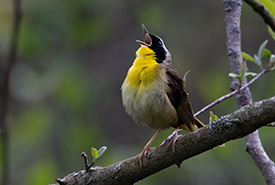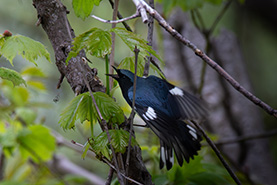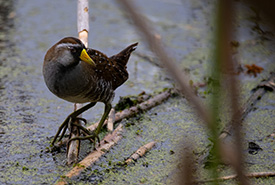Birders of a feather: Ethical wildlife photography

Common Yellowthroat,ON (Photo by Gen Pintel)
Over the past six years, birding and bird photography have become outlets for me to connect with nature. These pursuits also connect me with others, especially those who get just as excited as me when they come across a blackburnian warbler, Baltimore oriole or a pileated woodpecker (just to name a few). It’s how I’ve found mentors, inspired others and formed many long-lasting friendships.
For those of us who value nature and also love photographing it, it is vital to reflect on — and improve upon — our practices. Here are some things I keep in mind when capturing images of wildlife:

Blackthroated blue warbler bird, ON (Photo by Gen Pintel)
Be cautious of sharing species locations
Nowadays, when there’s a rare bird nearby, it’s difficult to miss. With group chat platforms, such as Discord “bird alert” channels and social media groups, the number of people receiving up-to-the-minute rare bird updates is only growing. Within a few seconds and the click of a button, the species and coordinates can be shared out to hundreds of bird enthusiasts far and wide. On social media, photographs and locations of sensitive species are also shared in community Facebook groups or on Instagram.
These types of connections are great for collecting data, and encouraging taking care toward wildlife, including local species at risk. However, the growing popularity of wildlife photography can also be a prime cause of disturbances to the species on the other side of the lens.
Keep your distance and keep noise levels minimal, especially if an animal is nesting
Many sensitive bird species, such as owls, are too often victims of overcrowding (with some people getting within a couple metres), loud noises, flushing (being spooked out of their roosting spot), and baiting for photographs and videos. They can eventually become habituated to humans and may be kept awake for hours during the day when they should otherwise be resting. These sensitive species may lose out on prey that are scared off by people, or they themselves may be left vulnerable to predators. If they react to your approach, you’re too close!

Sora,ON (Photo by Gen Pintel)
Avoid the use of flash, especially on nocturnal animals
Where I live in the Greater Toronto Area, some of my local parks have recently made efforts to curb disturbances and encourage respect for the wildlife that depend on these habitats. I have seen fencing installed to prevent photographers from entering roosting areas, signs on how to ethically watch wildlife, and the recruitment of volunteers who gently ask onlookers to give animals space. I have had to politely ask others to not use flash at night, as the harsh light can blind nocturnal animals.
Continue to learn and embrace the challenge
Ethical wildlife photography and the principles of leaving no trace are important reminders for birders and photographers, and especially so for budding photographers.
When enjoying, as we all do, a great photo or video of an animal, it is also important to consider if it was created ethically or if it may have affected an animal’s well-being.
Not only do these ethical practices make us better nature enthusiasts and stewards, they also offer us a challenge. Wildlife photography is all the more fun and thrilling when we do get that perfect image while knowing we made no effort to manipulate our environment and did our best to minimize disturbance to the animal.
As we go forth to document the wonderful nature around us, these are actions we can all keep in mind!


